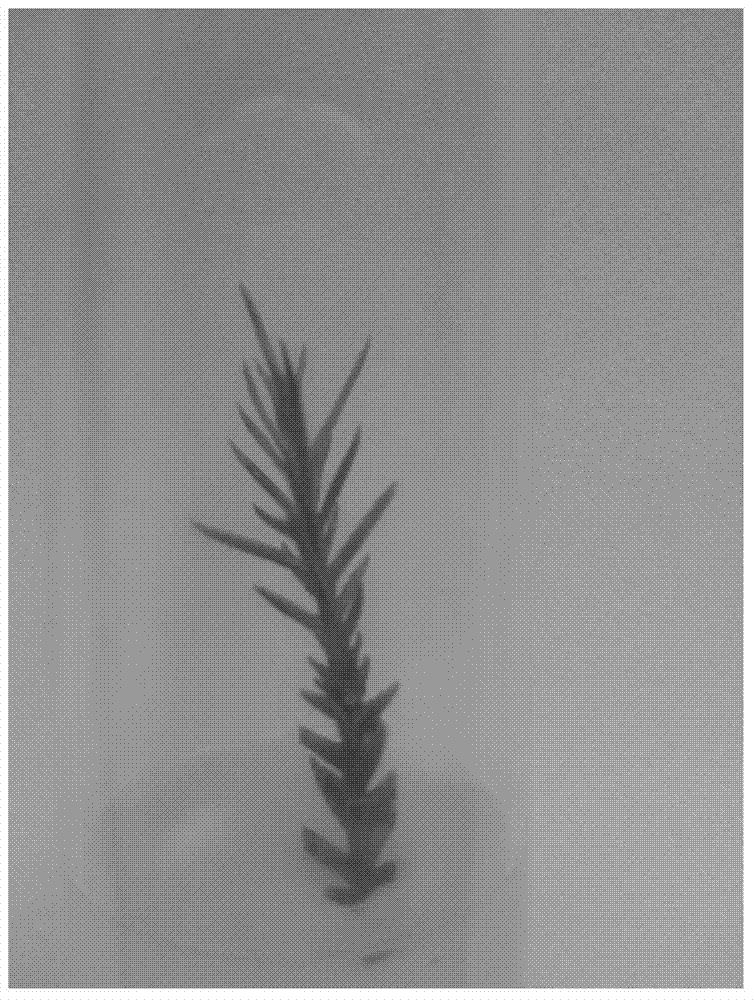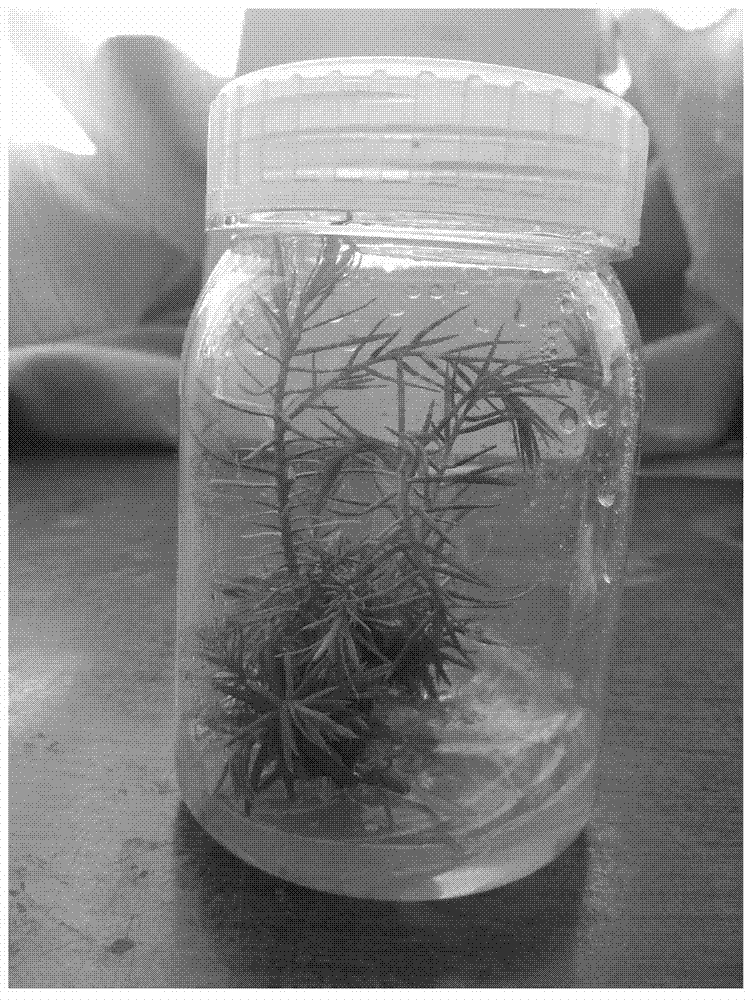Method for Obtaining Regenerated Plants from Cedar Stem Tissue Culture
A technology for tissue culture and regeneration of plants, applied in botany equipment and methods, plant regeneration, horticultural methods, etc., can solve problems such as danger, insufficient supply of high-quality seedlings, and low seed yield, so as to maintain good traits and promote healthy and rapid growth The effect of development
- Summary
- Abstract
- Description
- Claims
- Application Information
AI Technical Summary
Problems solved by technology
Method used
Image
Examples
Embodiment 1
[0026] (1) Take the stem material, soak it in detergent solution for 30 minutes, gently brush off the surface dust with a brush, and cut it into independent small branches with terminal buds, the length is 5cm, put the branches in a beaker, and rinse with running water 3h, dry the water, then soak in 0.2% carbendazim solution for 33min, wash twice with distilled water, put it in a sterile culture room for aseptic disinfection, and use 75% alcohol under the ultra-clean workbench After disinfection for 15 seconds, soak in 0.1% mercuric chloride for 7 minutes, then wash with sterile water for 5 times, and blot dry with sterile gauze for later use;
[0027] (2) Induction culture, cut off the 2.5cm stem segment, cut off 2 / 3 of the needle length, and insert it into the induction medium (the induction medium is WPM basic medium + 6-BA1.0mg.L -1 +IBA0.03mg.L -1 + 30g.L sucrose -1 +Agar 7g.L -1 ), cultured in a dark incubator for 100 hours, and then placed in a light incubator for c...
Embodiment 2
[0032] (1) Take the stem material, soak it in detergent solution for 25 minutes, gently brush off the surface dust with a brush, and cut it into independent small branches with terminal buds, the length is 5cm, put the branches in a beaker, and rinse with running water 3h, dry the water, soak in 0.2% carbendazim solution for 30min, wash twice with distilled water, put it in a sterile culture room for aseptic disinfection, and use 75% alcohol under the ultra-clean workbench After disinfection for 10 seconds, soak in 0.1% mercuric chloride for 6 minutes, then wash with sterile water for 4 times, and blot dry with sterile gauze for later use;
[0033] (2) Induction culture, cut off 2cm stem segments, cut off 2 / 3 of the needle length, and insert induction medium (induction medium is WPM basic medium + 6-BA0.8mg.L -1 +IBA0.05mg.L -1 + 30g.L sucrose -1 +Agar 7g.L -1 ), cultured in a dark incubator for 72 hours, and then placed in a light incubator, and the buds began to swell and...
Embodiment 3
[0038] (1) Take the stem material, soak it in detergent solution for 25 minutes, gently brush off the surface dust with a brush, and cut it into independent small branches with terminal buds, the length is 5cm, put the branches in a beaker, and rinse with running water 3h, dry the water, soak in 0.2% carbendazim solution for 30min, wash twice with distilled water, put it in a sterile culture room for aseptic disinfection, and use 75% alcohol under the ultra-clean workbench After disinfection for 10 seconds, soak in 0.1% mercuric chloride for 6 minutes, then wash with sterile water for 4 times, and blot dry with sterile gauze for later use;
[0039] (2) Induction culture, cut off 2cm stem segments, cut off 2 / 3 of the needle length, and insert induction medium (induction medium is WPM basic medium + 6-BA0.5mg.L -1 +IBA0mg.L -1 + 30g.L sucrose -1 +Agar 7g.L -1 ), cultured in a dark incubator for 72 hours, and then placed in a light incubator, and the buds began to swell and ge...
PUM
 Login to View More
Login to View More Abstract
Description
Claims
Application Information
 Login to View More
Login to View More - R&D
- Intellectual Property
- Life Sciences
- Materials
- Tech Scout
- Unparalleled Data Quality
- Higher Quality Content
- 60% Fewer Hallucinations
Browse by: Latest US Patents, China's latest patents, Technical Efficacy Thesaurus, Application Domain, Technology Topic, Popular Technical Reports.
© 2025 PatSnap. All rights reserved.Legal|Privacy policy|Modern Slavery Act Transparency Statement|Sitemap|About US| Contact US: help@patsnap.com



